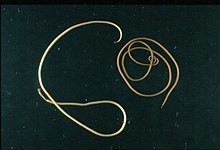
Back ديدان شعرية Arabic ديدان شعريه ARZ Qılqurdlar Azerbaijani Валасні Byelorussian Живи влакна Bulgarian Nematomorpha BS Nematomorfs Catalan Ulod nga buhok sa kabayo CEB Strunovci Czech Saitenwürmer German
| Nematomorpha Temporal range: Possible Atdabanian Record
| |
|---|---|

| |
| Paragordius tricuspidatus | |
| Scientific classification | |
| Domain: | Eukaryota |
| Kingdom: | Animalia |
| Subkingdom: | Eumetazoa |
| Clade: | ParaHoxozoa |
| Clade: | Bilateria |
| Clade: | Nephrozoa |
| (unranked): | Protostomia |
| Superphylum: | Ecdysozoa |
| Clade: | Nematoida |
| Phylum: | Nematomorpha Vejdovsky, 1886 |
| Orders and families | |
| |
Nematomorpha (sometimes called Gordiacea, and commonly known as horsehair worms, hairsnakes,[1][2][3] or Gordian worms) are a phylum of parasitoid animals superficially similar to nematode worms in morphology, hence the name. Most species range in size from 50 to 100 millimetres (2.0 to 3.9 in), reaching 2 metres (79 in) in extreme cases, and 1 to 3 millimetres (0.039 to 0.118 in) in diameter. Horsehair worms can be discovered in damp areas, such as watering troughs, swimming pools, streams, puddles, and cisterns. The adult worms are free-living, but the larvae are parasitic on arthropods, such as beetles, cockroaches, mantises, orthopterans, and crustaceans.[4] About 351 freshwater species are known[5] and a conservative estimate suggests that there may be about 2000 freshwater species worldwide.[6] The name "Gordian" stems from the legendary Gordian knot. This relates to the fact that nematomorphs often coil themselves in tight balls that resemble knots.[7]
- ^ Heston, Joshua. "Horse Hair Snake". State of the Ozarks. Retrieved 1 January 2021.
- ^ Troxell, W.H. (30 January 1903). "Erroneous Beliefs" (PDF). Emmitsburg Chronicle. No. 37. Archived (PDF) from the original on 2021-05-09. Retrieved 1 January 2021.
- ^ Ningewance, Pat (8–10 August 1996). "Naasaab Izhi-anishinaabebii'igeng conference report: a conference to find a common Anishinaabemowin writing system" (PDF). Toronto, Ontario: Literacy Ontario. p. 27. Archived (PDF) from the original on 2020-10-22.
Girls, don't swim without pants or a hairsnake will enter you.
- ^ Hanelt, B, F. Thomas, and A. Schmidt-Rhaesa (2005). "Biology of the phylum Nematomorpha". Advances in Parasitology Volume 59. Vol. 59. pp. 244–305. doi:10.1016/S0065-308X(05)59004-3. ISBN 9780120317592. PMID 16182867.
{{cite book}}:|journal=ignored (help)CS1 maint: multiple names: authors list (link) - ^ Zhang, Z.-Q. (2011). "Animal biodiversity: An introduction to higher-level classification and taxonomic richness" (PDF). Zootaxa. 3148: 7–12. doi:10.11646/zootaxa.3148.1.3. Archived (PDF) from the original on 2022-10-10.
- ^ Poinar Jr., G (January 2008). "Global diversity of hairworms (Nematomorpha: Gordiaceae) in freshwater". Hydrobiologia. 595 (1): 79–83. doi:10.1007/s10750-007-9112-3. S2CID 37985613.
- ^ Piper, Ross (2007), Extraordinary Animals: An Encyclopedia of Curious and Unusual Animals, Greenwood Press.
© MMXXIII Rich X Search. We shall prevail. All rights reserved. Rich X Search